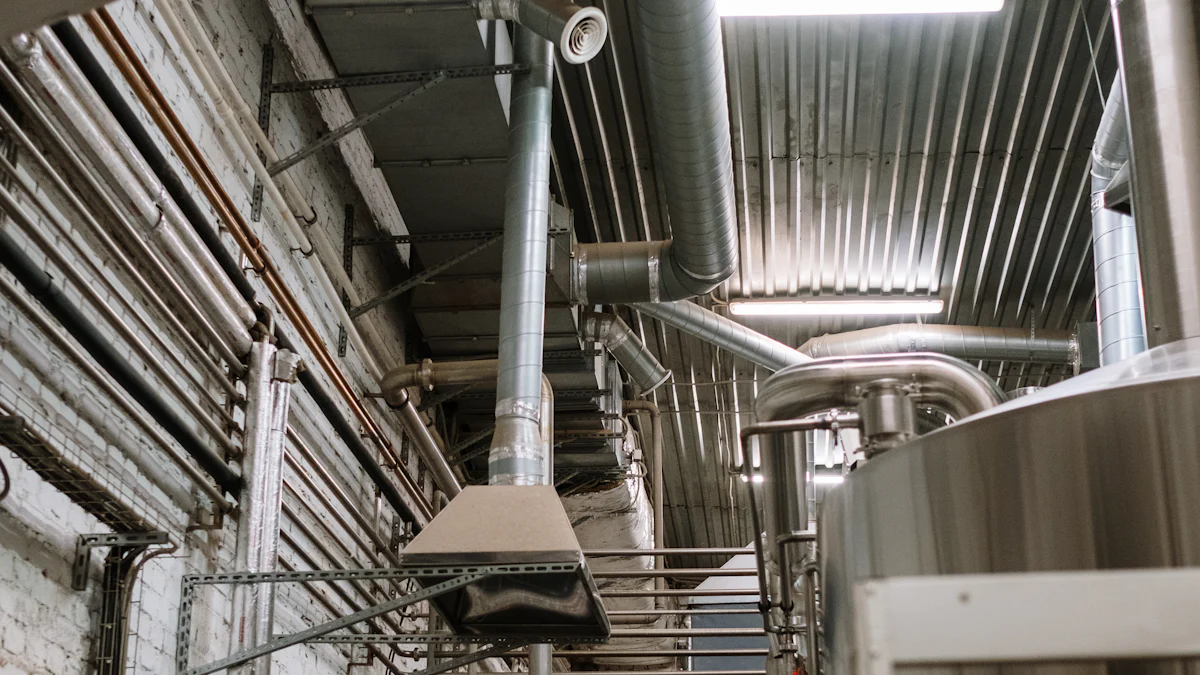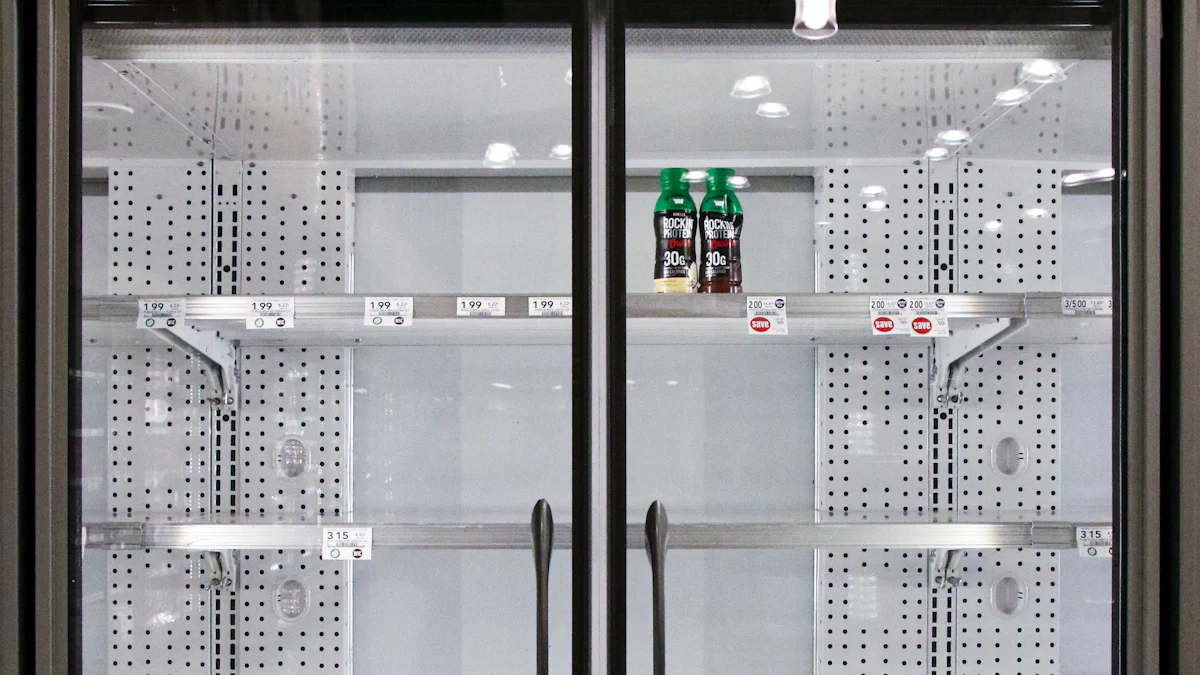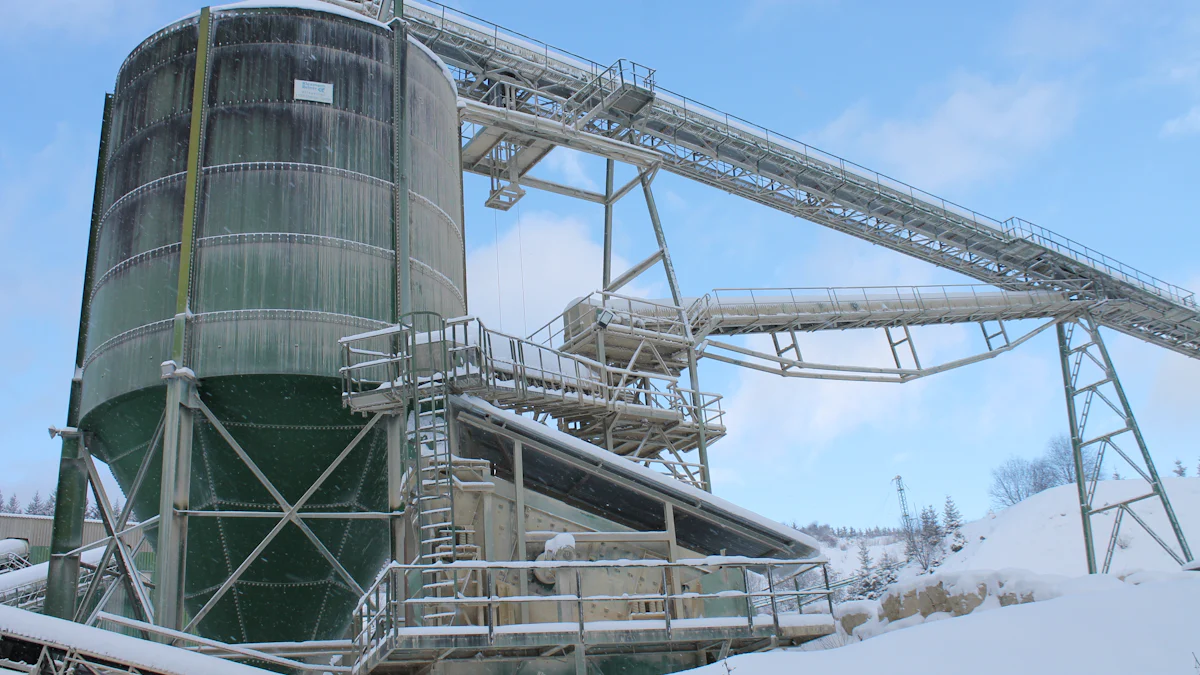Tunnel Freezers or Spiral Freezers: Choosing the Right Option

Industrial freezing plays a vital role in preserving food quality and extending shelf life. Among the most efficient options, the tunnel freezer and spiral freezer stand out for their unique designs and applications. A tunnel freezer uses a straight conveyor system within a freezing tunnel to achieve quick freezing, making it ideal for high-volume production. In contrast, a spiral freezer employs a helical conveyor, offering a compact freezing method that minimizes cell damage. Both rely on advanced quick freezing technology, but your choice depends on factors like space, production needs, and the type of individual quick freezing required.
What is a Tunnel Freezer?

A tunnel freezer is an advanced industrial freezing system designed to freeze food products rapidly and uniformly. It plays a crucial role in preserving the quality, texture, and flavor of food while ensuring safety standards are met. This type of freezer is commonly used in industries that require high-capacity freezing for bulk production. Its design and functionality make it a vital component in modern food processing.
How a Tunnel Freezer Works
The tunnel freezer operates within a long, enclosed chamber known as a freezing tunnel. Inside this chamber, a conveyor belt transports food products from one end to the other. As the products move through the tunnel, they are exposed to extremely cold air or cryogenic agents like liquid nitrogen. This controlled environment ensures rapid cooling, bringing the food to subzero temperatures in a short time. The linear movement of the conveyor allows for consistent and uniform freezing, making it ideal for high-speed production lines.
Key Advantages of a Tunnel Freezer
Using a tunnel freezer offers several benefits:
Rapid Freezing: The system ensures quick freezing, which helps maintain the natural texture and flavor of food. This is especially important for preserving the quality of meats, seafood, and ready-made meals.
High Capacity: It is well-suited for large-scale operations, handling significant volumes of food efficiently.
Uniform Results: The freezing process is consistent, ensuring that all products are frozen evenly.
Space Efficiency: Compared to other industrial freezers, the linear design of a tunnel freezer saves space, making it a practical choice for facilities with limited floor area.
Energy Efficiency: Advanced technology minimizes energy consumption while maintaining optimal freezing performance.
Common Disadvantages of a Tunnel Freezer
Despite its advantages, a tunnel freezer has some limitations:
Product Specificity: These freezers are often customized for specific product lines. This means they may not be versatile enough to handle a wide variety of products without modifications.
Initial Cost: The installation and setup of a tunnel freezer can be expensive due to its advanced technology and customization requirements.
Maintenance Needs: Regular maintenance is essential to ensure the system operates efficiently. This can add to operational costs over time.
Limited Flexibility: The linear design may not accommodate irregularly shaped or delicate items as effectively as other freezer types.
Best use cases for a tunnel freezer
A tunnel freezer excels in scenarios where rapid and uniform freezing is essential. Its design and functionality make it a preferred choice for industries that prioritize efficiency and high production volumes. Below are some of the most common and effective use cases for this type of freezer:
High-Volume Freezing Operations: If your business handles large quantities of food products, a tunnel freezer is an ideal solution. It can freeze bulk items like vegetables, fruits, or seafood quickly, ensuring consistent quality across all products.
Meat and Seafood Processing: Tunnel freezers are widely used in freezing meat carcasses, poultry, and fish. Their ability to maintain uniform freezing ensures that these products retain their texture, flavor, and safety standards.
Ready-Made Meals: For companies producing frozen meals, a freezing tunnel provides the speed and efficiency needed to meet high demand. It ensures that meals are frozen uniformly, preserving their taste and appearance.
Specialized Product Lines: If your production focuses on a specific product, such as pizzas or pre-packaged foods, a tunnel freezer can be customized to meet your exact requirements. Its linear design supports continuous freezing, making it perfect for streamlined operations.
Cold Chain Logistics: Businesses involved in cold chain logistics benefit from the rapid freezing capabilities of tunnel freezers. These systems help maintain the integrity of temperature-sensitive products, reducing the risk of spoilage during transportation.
Energy-Efficient Freezing: Companies aiming to minimize energy consumption while maintaining high freezing performance often choose tunnel freezers. Their advanced technology ensures optimal energy use without compromising on freezing speed or quality.
By integrating a tunnel freezer into your production line, you can achieve faster freezing times, better product preservation, and higher efficiency. Whether you operate in the meat industry, frozen meals sector, or cold chain logistics, this freezer type offers unmatched reliability and performance.
What is a Spiral Freezer?

A spiral freezer is an innovative industrial freezing system designed to optimize space while delivering consistent and efficient freezing. Its unique helical conveyor belt structure allows food products to move upward or downward in a spiral path within a compact chamber. This design makes it a preferred choice for industries that require gentle handling of products and efficient use of floor space.
How a Spiral Freezer Works
The spiral freezer operates by transporting food items on a continuous spiral conveyor belt. As the products travel through the spiral path, they are exposed to controlled cold air or cryogenic agents. This process ensures gradual and uniform cooling, which helps preserve the texture and quality of the food. The spiral design maximizes the freezing surface area, allowing you to freeze a large number of items in a relatively small footprint. This system is particularly effective for delicate or irregularly shaped products that require careful handling during the freezing process.
Key Advantages of a Spiral Freezer
Using a spiral freezer offers several benefits that make it a valuable asset in food production:
Space Efficiency: The spiral design minimizes the floor space required, making it ideal for facilities with limited room.
Gentle Handling: The system ensures minimal damage to delicate products, such as pastries or seafood, during freezing.
Continuous Operation: The conveyor belt allows for a steady flow of products, improving production efficiency.
Versatility: It accommodates a wide range of food items, including baked goods, ready meals, and processed meats.
Energy Efficiency: Advanced technology reduces energy consumption while maintaining consistent freezing performance.
Common Disadvantages of a Spiral Freezer
Despite its advantages, a spiral freezer has some limitations that you should consider:
Higher Initial Cost: The advanced design and technology make it more expensive to purchase and install compared to other freezer types.
Maintenance Complexity: The intricate conveyor system requires regular upkeep, which can increase operational costs.
Slower Freezing Speed: Compared to tunnel freezers, spiral freezers may take longer to achieve the desired freezing temperature.
Space Requirements: While compact, the vertical design may still require sufficient ceiling height, which could be a limitation in some facilities.
By understanding how a spiral freezer works and evaluating its advantages and disadvantages, you can determine if it aligns with your production needs. This system is particularly beneficial for businesses that prioritize space efficiency and gentle product handling.
Best use cases for a spiral freezer
A spiral freezer proves invaluable in industries where space efficiency and gentle product handling are priorities. Its unique design and functionality make it suitable for a variety of applications, ensuring consistent freezing while preserving product quality. Below are some of the most common and effective use cases for this type of freezer:
Delicate Food Items: If your business handles fragile products like pastries, seafood, or desserts, a spiral freezer ensures minimal damage during the freezing process. The gentle movement of the helical conveyor protects the structure and texture of these items.
Baked Goods: For bakeries, freezing baked goods quickly while maintaining their moisture and texture is essential. Spiral freezers help retain the freshness and taste of bread, cakes, and other baked products, extending their shelf life without compromising quality.
Ready-Made Meals: Companies producing frozen meals benefit from the spiral freezer's ability to handle a continuous flow of products. It ensures uniform freezing, preserving the flavor and nutritional content of meals while meeting high production demands.
Processed Meats and Poultry: Spiral freezers are ideal for freezing processed meats, sausages, and poultry products. Their compact design allows you to freeze large quantities efficiently, even in facilities with limited floor space.
Cold Chain Logistics: Businesses involved in cold chain logistics rely on spiral freezers to maintain the integrity of temperature-sensitive products. These freezers ensure consistent freezing, reducing the risk of spoilage during storage and transportation.
Energy-Conscious Operations: If energy efficiency is a priority, spiral freezers offer advanced technology that minimizes energy consumption. This makes them an excellent choice for businesses aiming to reduce operational costs while maintaining high freezing performance.
By integrating a spiral freezer into your production line, you can optimize space, enhance product quality, and improve overall efficiency. Whether you operate in the bakery sector, ready-meal production, or cold chain logistics, this freezer type provides a reliable solution tailored to your needs.
Key Differences Between Tunnel and Spiral Freezers
Space requirements for tunnel freezers vs. spiral freezers
When considering space, tunnel freezers and spiral freezers differ significantly in their designs. A tunnel freezer features a linear structure, which makes it ideal for facilities with limited ceiling height but ample floor space. Its straight conveyor system requires a longer layout, so you need to allocate sufficient horizontal space for installation. This design works well in production lines where the freezing tunnel can seamlessly integrate into the workflow.
In contrast, a spiral freezer uses a helical conveyor belt that stacks vertically. This compact design minimizes the floor space required, making it a better choice for facilities with restricted floor areas but adequate ceiling height. The vertical arrangement allows you to freeze large quantities of products without needing a sprawling layout. If your facility has space constraints, the spiral freezer offers a more efficient footprint.
Energy efficiency comparison
Energy efficiency plays a crucial role in choosing the right freezer. Tunnel freezers excel in rapid freezing, which reduces the time products spend in the freezing tunnel. This quick freezing process minimizes energy consumption per unit of product, making it an energy-efficient option for high-volume operations. The linear design also ensures uniform airflow, which contributes to consistent freezing and reduced energy waste.
Spiral freezers, on the other hand, focus on maintaining product quality while optimizing energy use. Their 360-degree freezing method ensures even cooling across all surfaces, which reduces the risk of energy loss. Although spiral freezers may take slightly longer to freeze products compared to tunnel freezers, their advanced technology compensates by minimizing dehydration and preserving food quality. Over time, this energy-conscious design can lead to significant savings, especially for businesses prioritizing long-term operational efficiency.
Product types and volumes each freezer can handle
The type and volume of products you need to freeze will heavily influence your choice. Tunnel freezers are designed for high-capacity operations, making them ideal for freezing bulk items like vegetables, seafood, and ready-made meals. Their rapid freezing capability ensures that large volumes of food can be processed quickly without compromising quality. However, the linear conveyor system may not handle delicate or irregularly shaped products as effectively.
Spiral freezers, with their gentle handling and versatile design, are better suited for delicate items such as pastries, seafood, and baked goods. The helical conveyor belt accommodates a continuous flow of products, allowing you to freeze smaller batches or individually quick frozen (IQF) items efficiently. While spiral freezers may not match the sheer volume capacity of tunnel freezers, they excel in preserving the texture and structure of fragile products.
By understanding these key differences, you can determine which freezer aligns best with your production needs. Whether you prioritize space efficiency, energy savings, or product versatility, both options offer unique advantages tailored to specific applications.
Maintenance and cost considerations
When evaluating tunnel freezers and spiral freezers, maintenance and cost considerations play a critical role in your decision-making process. Each freezer type has unique requirements that can impact your operational budget and long-term efficiency.
Maintenance Requirements
Tunnel freezers typically feature a straightforward linear design, which simplifies maintenance tasks. The straight conveyor system allows for easier access to components, reducing the time and effort needed for cleaning and repairs. However, regular upkeep is essential to ensure optimal performance. You must frequently inspect the conveyor belt, cooling systems, and insulation to prevent wear and tear. Neglecting maintenance can lead to inefficiencies and higher energy consumption.
Spiral freezers, on the other hand, have a more intricate design due to their helical conveyor system. This complexity demands a higher level of maintenance expertise. The spiral structure requires careful cleaning to avoid residue buildup, which could compromise hygiene and freezing efficiency. Additionally, the conveyor belt's continuous movement necessitates regular lubrication and alignment checks. While these tasks may seem demanding, they are crucial for maintaining the freezer's performance and extending its lifespan.
Cost Considerations
The initial investment for a tunnel freezer is generally lower compared to a spiral freezer. Its simpler design and fewer components contribute to reduced upfront costs. Tunnel freezers also tend to have lower operational expenses, as their rapid freezing process minimizes energy usage per unit of product. If your production line focuses on high-volume freezing with limited product variety, a tunnel freezer offers a cost-effective solution.
Spiral freezers, while more expensive to purchase and install, provide long-term value through their energy-efficient design. The 360-degree freezing method ensures even cooling, reducing energy waste over time. This efficiency can lead to significant savings, especially for businesses prioritizing sustainability. Additionally, spiral freezers excel in preserving the quality of delicate or irregularly shaped products, which can justify the higher initial cost if product integrity is a priority.
Balancing Costs and Benefits
To make an informed choice, you should weigh the maintenance demands and cost implications of each freezer type against your production needs. If you prioritize ease of maintenance and lower upfront costs, a tunnel freezer may align better with your goals. Conversely, if you value energy efficiency and the ability to handle diverse product types, investing in a spiral freezer could yield greater long-term benefits.
By understanding these factors, you can select a freezer that not only meets your operational requirements but also supports your budget and maintenance capabilities.
How to Choose the Right Freezer for Your Needs
Selecting the right freezer for your production line requires careful evaluation of your specific needs. Each freezer type offers unique benefits, so understanding these differences will help you make an informed decision.
Factors to consider when choosing between a tunnel freezer and a spiral freezer
When deciding between these two freezer types, you should focus on several critical factors:
Available Space: Assess the layout of your facility. If you have limited floor space but sufficient ceiling height, a spiral freezer may be the better option. Its vertical design optimizes space usage. On the other hand, if your facility has more horizontal space, a tunnel freezer's linear structure could integrate seamlessly into your production line.
Production Volume: Consider the scale of your operations. For high-volume production, quick freezing is essential to maintain efficiency. A tunnel freezer excels in this area, making it ideal for bulk freezing. However, if your production involves smaller batches or delicate items, a spiral freezer provides the gentle handling required.
Product Type: Evaluate the nature of the products you freeze. Spiral freezers are well-suited for fragile or irregularly shaped items like pastries or seafood. Their gentle conveyor system minimizes damage. For uniform products that require rapid freezing, a tunnel freezer delivers consistent results.
Energy Efficiency: Factor in long-term operational costs. Tunnel freezers consume less energy per unit due to their rapid freezing process. Spiral freezers, while slightly slower, use advanced technology to reduce energy waste and preserve product quality.
Budget: Determine your budget for both initial investment and ongoing maintenance. Tunnel freezers typically have lower upfront costs and simpler maintenance requirements. Spiral freezers, though more expensive, offer long-term value through energy savings and versatility.
By analyzing these factors, you can narrow down your options and identify the freezer type that aligns with your operational goals.
Decision-making tips for selecting the right freezer
To simplify your decision-making process, follow these practical tips:
Define Your Priorities: Identify what matters most to your business. Is it freezing speed, space efficiency, or product quality? Knowing your priorities will guide your choice.
Consult with Experts: Reach out to freezer manufacturers or industry professionals. They can provide insights into the latest technologies and recommend solutions tailored to your needs.
Test Before You Invest: Whenever possible, request a demonstration or trial. Observing how a freezer handles your specific products can help you evaluate its performance.
Plan for the Future: Consider your long-term goals. If you anticipate scaling up production, choose a freezer that can accommodate growth without requiring significant upgrades.
Balance Costs and Benefits: Weigh the initial investment against potential savings. While a spiral freezer may cost more upfront, its energy efficiency and ability to handle diverse products could offset the expense over time.
Pro Tip: Spiral freezers not only enhance productivity but also ensure food safety in high-volume production environments. This makes them a valuable asset for businesses aiming to maintain quality while meeting demand.
By following these tips, you can confidently select a freezer that supports your production needs and aligns with your business objectives.
Choosing between a spiral freezer and a tunnel freezer requires a clear understanding of their differences. Spiral freezers excel in space efficiency and gentle product handling, while tunnel freezers prioritize rapid and uniform freezing. Evaluating your production needs, available space, and budget will help you make the right decision.
To simplify your choice, focus on three key factors: the type of products you freeze, the volume of production, and your facility's layout. By aligning these factors with your business goals, you can select the freezer that ensures optimal performance and efficiency.
See Also
Comparing Tunnel Freezers And Spiral Freezers: Key Differences
Cost And Efficiency Comparison: Spiral Versus Tunnel Freezers
Your Essential Guide To Purchasing Tunnel Freezers

